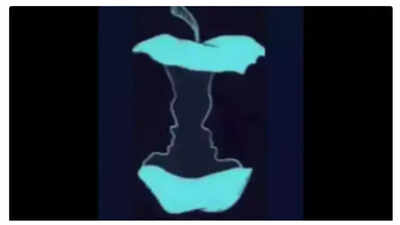Optical illusions are not just fun brain teasers; they can also offer intriguing insights into your personality. These visual puzzles challenge our perception, and the way we interpret them can reveal surprising aspects of our thought processes and emotional tendencies.
This particular illusion, recently shared by Marina Winberg on social media, presents a classic dual image: do you see an eaten apple, or do you perceive two faces gazing at each other? Your initial reaction to this image could uncover a deep secret about your personality.

According to Winberg, the first image that captures your attention speaks volumes about your mindset:
Optical illusions occur because our brains don't always perceive the world exactly as it is. These illusions exploit the way our visual system processes information, leading us to see things that may not be entirely accurate.
There are three primary categories of optical illusions:
Optical illusions are more than just a source of entertainment; they provide a fascinating glimpse into the complex workings of our minds and how we perceive the world around us. So, the next time you encounter an optical illusion, take a moment to consider what it might reveal about you.
Newer articles
Older articles
 India's Harshit Rana Released from Squad Ahead of Second England Test in Birmingham
India's Harshit Rana Released from Squad Ahead of Second England Test in Birmingham
 Phone Grip Personality Test: What Your Hand Position Reveals About You
Phone Grip Personality Test: What Your Hand Position Reveals About You
 Gujarat Cricket Association to Debut T20 League in 2025-26 Season
Gujarat Cricket Association to Debut T20 League in 2025-26 Season
 Najmul Hossain Resigns as Bangladesh Test Captain Following Series Defeat
Najmul Hossain Resigns as Bangladesh Test Captain Following Series Defeat
 Chess Sensation: Nine-Year-Old Indian Prodigy Holds Magnus Carlsen to Draw in Online Tournament
OR
Chess World Stunned: 9-Year-Old Indian Player Draws Against Magnus Carlsen; Carlsen Reaches Unprecedented Freestyle Chess Rating
Chess Sensation: Nine-Year-Old Indian Prodigy Holds Magnus Carlsen to Draw in Online Tournament
OR
Chess World Stunned: 9-Year-Old Indian Player Draws Against Magnus Carlsen; Carlsen Reaches Unprecedented Freestyle Chess Rating
 Smith Poised for Grenada Test Return, Boosting Australia's Lineup
Smith Poised for Grenada Test Return, Boosting Australia's Lineup
 Smith's Century Roars Barmy Army to Life, Edgbaston Test Grips Fans
Smith's Century Roars Barmy Army to Life, Edgbaston Test Grips Fans
 Nitish Rana Eyes Delhi Return After Disappointing Uttar Pradesh Stint
Nitish Rana Eyes Delhi Return After Disappointing Uttar Pradesh Stint
 SA20 Teams Granted Six Retentions Ahead of Player Auction
SA20 Teams Granted Six Retentions Ahead of Player Auction
 England Captain Stokes Credits Opening Duo for Setting Up Thrilling Chase Against India
England Captain Stokes Credits Opening Duo for Setting Up Thrilling Chase Against India